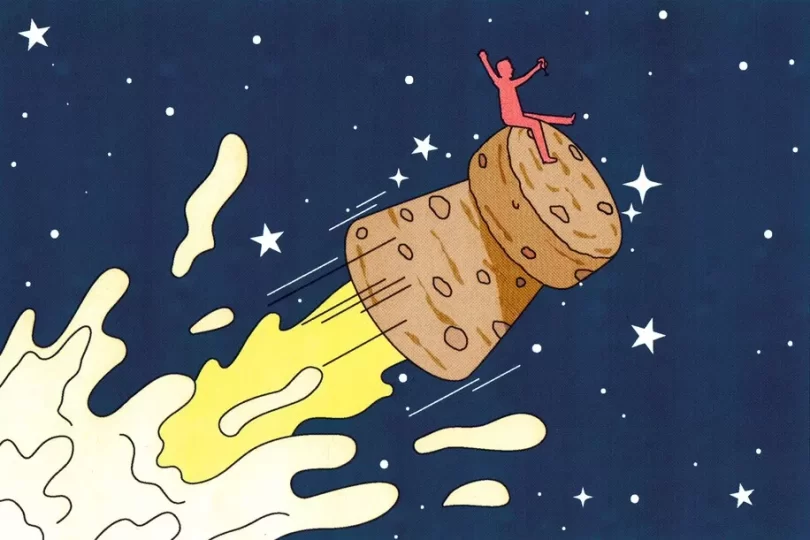Alcohol is one of the most-used drugs in the world. Millions of people enjoy the tipsy feeling it produces, especially in social gatherings where a little booze seems to make the good times flow.
In one study, over 700 male and female social drinkers were divided into groups of three strangers and instructed to drink for 36 minutes. The participants thought the drinks were a prelude to the experiment, but researchers were observing what they did at the table.
Initially, the strangers did not smile much. But as they consumed their vodka cranberry drinks, their expressions changed. They not only smiled more, but also caught each other’s smiles, and spoke more in succession. And they shared more of what researchers called “golden moments” when all three strangers smiled as one.
“It feels like the group is really coming together, and I think they’re part of that social, tipsy kind of experience,” said Michael Sayette, director of the Alcohol and Smoking Research Laboratory at the University of Pittsburgh who was a co-author of the study.
What is it about being tipsy that is enjoyable?
Alcohol disinhibits the brain
Drinking is societally accepted but “alcohol is just like any other drug,” said Jodi Gilman, psychiatry professor at Harvard Medical School and director of neuroscience for Massachusetts General Hospital’s Center for Addiction Medicine. “It affects the brain.”
Ethanol, the remarkably simple chemical compound that gives alcoholic drinks their buzz, permeates the cells of our body and brain within minutes of consumption. There is still a lot we do not know about alcohol’s effects on the brain. “It has such widespread effects in the brain,” said Jessica Weafer, a psychologist at the University of Kentucky. Unlike other drugs that affect particular brain regions or act on specific receptors, “alcohol is just kind of going all over the brain” making it difficult to study, she said.
Alcohol is widely known to be a depressant, meaning it generally suppresses neural activity in the brain. It amplifies the effects of brain chemicals that inhibit neural activity — GABA and glycine — by acting on the same receptors those neurotransmitters bind to. At the same time, alcohol inhibits the effects of excitatory brain chemicals, producing a double-whammy of reducing brain activity.
But it is not so simple.
As most people who drink may know, alcohol has a biphasic effect: initially and in low doses, it produces a buzz where we feel stimulated and disinhibited like we can dance or converse forever, before sleepiness settles in.
This rise and fall of our spirits corresponds with the rise and fall of our blood alcohol levels.
A look inside the inebriated brain
To see what happens in the inebriated brain, researchers gave willing participants alcohol via IV lines while they lay down inside fMRI neuroimaging scanners.
Alcohol may cause us to become disinhibited by dampening activity in parts of our frontal cortex, which is important for executive control functions such as inhibiting behaviors we don’t want to do. By inhibiting our inhibitions, alcohol makes us feel more stimulated.
Being pleasantly buzzed also releases dopamine and increases activity in the striatum, a key brain region associated with rewarding stimuli. Weafer and her colleagues found that neural activity in the striatum corresponded to how stimulated alcohol made the participants feel.
The participants were getting the alcohol intravenously, but still “they enjoy it, even though they are just kind of laying down in a scanner,” Weafer said.
Alcohol affects the emotion centers of the brain as well. In one study, alcohol dampened the neural responses in the amygdala to negative facial expressions, which may be a reason drinking can serve as a social lubricant, said Gilman, who led the study.
A bit of liquid courage may help us become less sensitive to rejection or social anxiety. But it could also lead to bar fights or inappropriate behavior when someone has had too much to drink.
Social context matters, too
The intoxicating powers of alcohol are not pharmacological alone.
“The funny thing about brains is that brains like to hang out with other brains,” Sayette said. “What does the brain look like when you drink varies dramatically, depending on whether you’re by yourself, or whether you’re in a social situation.”
Being around others in a social setting can itself be intoxicating, and alcohol seems to amplify the good feelings. It also provides a signal to others that we are letting our hair down, which does not require an intoxicating dose to see the mood effects, Sayette said.
He points to a study in the 1970s that asked how people felt after they came into the lab and drank by themselves or in a group. When people drank alone, they talked more about the physiological effects such as dizziness than changes to their mood. But when drinking in a social context, they talked more about feeling elated and not the body effects.
“It’s not distilled down to extra release of dopamine,” Sayette said. “That’s too simplistic.”
How to enjoy, responsibly
Even though studies show that no amount of alcohol is healthy and alcohol use disorders can be deadly, many can enjoy a couple of drinks on occasion.
When going out for a night of drinking, here are what researchers recommend:
Have a plan. How much will you drink? How will you get home? These decisions are easier to make when you aren’t disinhibited.
Eat food beforehand. This slows down alcohol metabolism. And drink plenty of water.
Know your limits. Each person has a different tolerance level. Slurring speech or loss of coordination can be warning signs to slow down. “You need to know when you’re feeling like you have lost control of your drinking,” Gilman said.
Know why you are drinking. If you are drinking to numb negative feelings or despite negative consequences, that could be a sign to talk to someone for help.
“It is certainly possible to be a responsible drinker,” Gilman said. “I think many people can have a drink at the holidays and be totally fine.”







